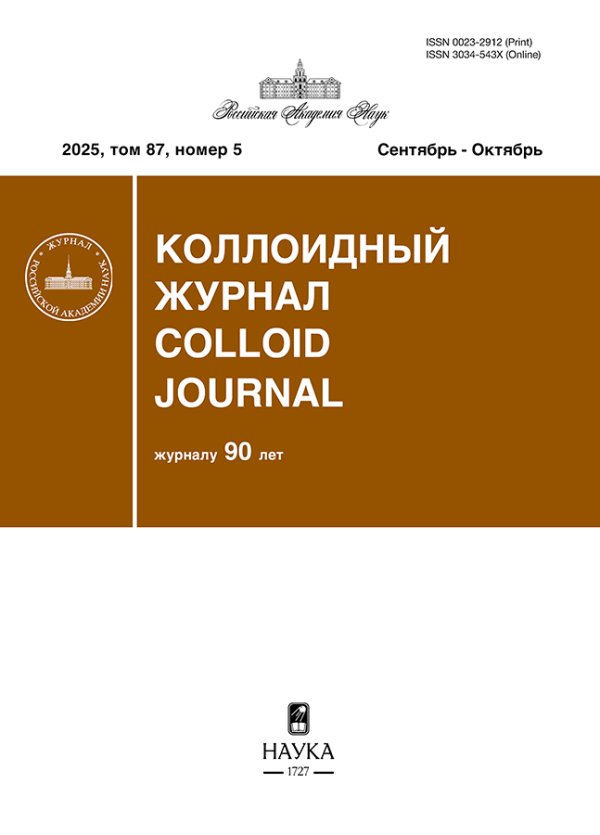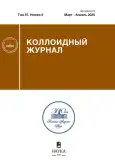Micellar and antimicrobial properties of a series of bis-quaternary ammonium compounds based on DABCO derivatives
- Authors: Shaihutdinova Z.M.1,2, Sapunova A.S.1, Salakhieva D.V.2, Pashirova T.N.1, Voloshina A.D.1, Bogdanov A.V.1
-
Affiliations:
- Institute of Organic and Physical Chemistry named after A.E. Arbuzov, Kazan Scientific Center RAS
- Kazan (Volga region) Federal University
- Issue: Vol 87, No 2 (2025)
- Pages: 161-170
- Section: Articles
- Submitted: 18.08.2025
- Published: 15.03.2025
- URL: https://journals.rcsi.science/0023-2912/article/view/304834
- DOI: https://doi.org/10.31857/S0023291225020087
- EDN: https://elibrary.ru/tonlho
- ID: 304834
Cite item
Abstract
About the authors
Z. M. Shaihutdinova
Institute of Organic and Physical Chemistry named after A.E. Arbuzov, Kazan Scientific Center RAS; Kazan (Volga region) Federal UniversityAkademika Arbuzova St., 8, Kazan, 420088 Russia; Kremlovskaya St., 18, Kazan, 420008 Russia
A. S. Sapunova
Institute of Organic and Physical Chemistry named after A.E. Arbuzov, Kazan Scientific Center RASAkademika Arbuzova St., 8, Kazan, 420088 Russia
D. V. Salakhieva
Kazan (Volga region) Federal UniversityKremlovskaya St., 18, Kazan, 420008 Russia
T. N. Pashirova
Institute of Organic and Physical Chemistry named after A.E. Arbuzov, Kazan Scientific Center RAS
Email: tatyana_pashirova@mail.ru
Akademika Arbuzova St., 8, Kazan, 420088 Russia
A. D. Voloshina
Institute of Organic and Physical Chemistry named after A.E. Arbuzov, Kazan Scientific Center RASAkademika Arbuzova St., 8, Kazan, 420088 Russia
A. V. Bogdanov
Institute of Organic and Physical Chemistry named after A.E. Arbuzov, Kazan Scientific Center RASAkademika Arbuzova St., 8, Kazan, 420088 Russia
References
- Obłąk E., Futoma-Kołoch B.,Wieczyńska A. Biological activity of quaternary ammonium salts and resistance of microorganisms to these compounds // World J. Microbiol. Biotechnol. 2021. V. 37. P. 22. https://doi.org/10.1007/s11274-020-02978-0
- Hu Y., Xing Y., Yue H. et al. Ionic liquids revolutionizing biomedicine: recent advances and emerging opportunities // Chem. Soc. Rev. 2023. v. 52. p. 7262–7293. https://doi.org/10.1039/D3CS00510K
- Saverina E.A., Frolov N.A., Kamanina O.A. et al. From antibacterial to antibiofilm targeting: An emerging paradigm shift in the development of quaternary ammonium compounds (QACs) // ACS Infect. Dis. 2023. v. 9. № 3. p. 394–422. https://doi.org/10.1021/acsinfecdis.2c00469
- Zakharova L.Y., Pashirova T.N., Doktorovova S. et al. Cationic surfactants: Self-assembly, structure-sctivity sorrelation and their biological applications // Int. J. Mol. Sci. 2019. v. 20. № 22. p. 5534. https://doi.org/10.3390/ijms20225534
- Frantz A.L. Chronic quaternary ammonium compound exposure during the COVID-19 pandemic and the impact on human health // Toxicol. Environ. Health Sci. 2023. V. 15. P. 199–206. https://doi.org/10.1007/s13530-023-00173-w
- Arnold W.A, Blum A., Branyan J. et al. Quaternary ammonium compounds: A chemical class of emerging concern // Environ. Sci. Technol. 2023. v. 57. № 20. p. 7645–7665. https://doi.org/10.1021/acs.est.2c08244
- Raj S., Ramamurthy K. Classification of surfactants and admixtures for producing stable aqueous foam // Adv. Colloid Interface Sci. 2024. V. 331. P. 103234. https://doi.org/10.1016/j.cis.2024.103234
- Bjerk T.R., Severino P., Jain S. et al. Biosurfactants: properties and applications in drug delivery, biotechnology and ecotoxicology // Bioengineering. 2021. v. 8. № 8. p. 115. https://doi.org/10.3390/bioengineering8080115
- Vavina A.V., Seitkalieva M.M., Strukova E.N. et al. Fatty acid-derived ionic liquids as soft and sustainable antimicrobial agents // J. Mol. Liq. 2024. v. 410. p. 125483. https://doi.org/10.1016/j.molliq.2024.125483
- Pashirova T.N., Shaikhutdinova Z.M., Mironov V.F. et al. Ammonium amphiphiles based on natural compounds: Design, synthesis, properties, and biomedical applications. A Review // Dokl. Chem. 2023. V. 509. p. 71–88. https://doi.org/10.1134/S0012500823700179
- Pernak J., Rzemieniecki T., Klejdysz T. et al. Conversion of quinine derivatives into biologically active ionic liquids: Advantages, multifunctionality, and perspectives // ACS Sustain. Chem. Eng. 2020. v. 8. № 25. p. 9263–9267. https://doi.org/10.1021/acssuschemeng.0c03501
- Bazina L., Maravić A., Krce L. et al. Discovery of novel quaternary ammonium compounds based on quinuclidine-3-ol as new potential antimicrobial candidates // Eur. J. Med. Chem. 2019. v. 163. p. 626–635. https://doi.org/10.1016/j.ejmech.2018.12.023
- Burilova E.A., Pashirova T.N., Lukashenko S.S. et al. Synthesis, biological evaluation and structure-activity relationships of self-assembled and solubilization properties of amphiphilic quaternary ammonium derivatives of quinuclidine // J. Mol. Liq. 2018. v. 272. p. 722–730. https://doi.org/10.1016/j.molliq.2018.10.008
- Pashirova T.N., Zhil’tsova E.P., Kashapov R.R. et al. Supramolecular systems based on 1-alkyl-4-aza-1-azoniabicyclo[2.2.2]octane bromides // Russ. Chem. Bull. 2010. V. 59. P. 1745–1752. https://doi.org/10.1007/s11172-010-0307-9
- Gilbert P., Al-taae A. Antimicrobial activity of some alkyltrimethylammonium bromides // Lett. Appl. Microbiol. 1985. V. 1. № 6. P. 101–104. https://doi.org/10.1111/j.1472-765X.1985.tb01498.x
- Lainioti G.C. Druvari D. Designing antibacterial-based quaternary ammonium coatings (surfaces) or films for biomedical applications: Recent advances // Int. J. Mol. Sci. 2024. V. 25. № 22. p. 12264. https://doi.org/10.3390/ijms252212264
- Dan W., Gao J., Qi X., et. al. Antibacterial quaternary ammonium agents: Chemical diversity and biological mechanism // Eur. J. Med. Chem. 2022. V. 243. p. 114765. https://doi.org/10.1016/j.ejmech.2022.114765
- Zhou C., Wang Y. Structure–activity relationship of cationic surfactants as antimicrobial agents // Curr. Opin. Colloid Interface Sci. 2020. V. 45. P. 28–43. https://doi.org/10.1016/j.cocis.2019.11.009
- Zhou C., Wang F., Chen H. et al. Selective antimicrobial activities and action mechanism of micelles self-assembled by cationic oligomeric surfactants // ACS Appl. Mater. Interfaces. 2016. V. 8. № 6. P. 4242–4249. https://doi.org/10.1021/acsami.5b12688
- Jennings J., Ašćerić D., Semeraro E.F. et al. Combinatorial screening of cationic lipidoids reveals how molecular conformation affects membrane-targeting antimicrobial cctivity // ACS Appl. Mater. Interfaces. 2023. V. 15. № 34. P. 40178–40190. https://doi.org/10.1021/acsami.3c05481
- Subedi Y.P., Alfindee M.N., Shrestha J.P. et al. Tuning the biological activity of cationic anthraquinone analogues specifically toward Staphylococcus aureus // Eur. J. Med. Chem. 2018. V. 157. P. 683–690. https://doi.org/10.1016/j.ejmech.2018.08.018
- Nadagouda M.N., Vijayasarathy P., Sin A. et al. Antimicrobial activity of quaternary ammonium salts: structure-activity relationship // Med. Chem. Res. 2022. V. 31. P. 1663–1678. https://doi.org/10.1007/s00044-022-02924-9
- Forman M.E., Jennings M.C., Wuest W.M. et al. Building a better quaternary ammonium compound (QAC): Branched tetracationic antiseptic amphiphiles // ChemMedChem. 2016. V. 11. № 13. P. 1401–1405. https://doi.org/10.1002/cmdc.201600176
- Kontos R.C., Schallenhammer S.A., Bentley B.S. et al. An Investigation into rigidity–activity relationships in BisQAC amphiphilic antiseptics // ChemMedChem. 2019. V. 14. № 1. P. 83–87. https://doi.org/10.1002/cmdc.201800622
- Frolov N.A., Fedoseeva K.A., Hansford K.A. et al. Novel phenyl‐based bis‐quaternary ammonium compounds as broad‐spectrum biocides // ChemMedChem. 2021. V. 16. № 19. P. 2954–2959. https://doi.org/10.1002/cmdc.202100284
- Thomas B., Duval R.E., Fontanay S. et al. Synthesis and antibacterial evaluation of bis‐thiazolium, bis‐imidazolium, and bis‐triazolium derivatives // ChemMedChem. 2019. V. 14. № 13. P. 1232–1237. https://doi.org/10.1002/cmdc.201900151
- Pashirova T.N., Zhil´tsova E.P., Lukashenko S.S. et al. Catalytic properties of polymer-colloid complexes based on polyethyleneimines and mono- and diquaternized 1,4-diazabicyclo[2.2.2]octane derivatives in the hydrolysis of phosphorus acids esters // Russ. Chem. Bull. 2015. V. 64. P. 2879–2884. https://doi.org/10.1007/s11172-015-1242-6
- Zhiltsova E.P, Lukashenko S.S., Pashirova T.N. et al. Self-assembling systems based on diquaternized derivatives of 1,4-diazabicyclo[2.2.2]octane // J. Mol. Liq. 2015. V. 210. P. 136–142. https://doi.org/10.1016/j.molliq.2015.01.018
- Pashirova T.N., Burilova E.A., Lukashenko S.S. et al. Nontoxic antimicrobial micellar systems based on mono- and dicationic Dabco-surfactants and furazolidone: Structure-solubilization properties relationships // J. Mol. Liq. 2019. V. 296. p. 112062. https://doi.org/10.1016/j.molliq.2019.112062
- Zakharova L.Y., Gaysin N.K., Gnezdilov O.I. et al. Micellization of alkylated 1.4-diazabicyclo[2.2.2]octane by nuclear magnetic resonance technique using pulsed gradient of static magnetic field // J. Mol. Liq. 2012. V. 167. P. 89–93. https://doi.org/10.1016/j.molliq.2011.12.015
- Voloshina A.D., Sapunova A.S., Kulik N.V. et al. Antimicrobial and cytotoxic effects of ammonium derivatives of diterpenoids steviol and isosteviol // Bioorg. Med. Chem. 2021. V. 32. p. 115974. https://doi.org/10.1016/j.bmc.2020.115974
- Rosen M.J., Kunjappu J.T. Surfactants and interfacial phenomena. John Wiley & Sons, Inc. 2012. https://doi.org/10.1002/9781118228920
- Song L.D., Rosen M.J. Surface properties, micellization, and premicellar aggregation of gemini surfactants with rigid and flexible spacers // Langmuir. 1996. V. 12. № 5. P. 1149–1153. https://doi.org/10.1021/la950508t
- Rosen M.J., Liu L. Surface activity and premicellar aggregation of some novel diquaternary gemini surfactants // J. Am. Oil Chem. Soc. 1996. V. 73. № 7. P. 885–890. https://doi.org/10.1007/BF02517990
- Tsubone K., Arakawa Y., Rosen M.J. Structural effects on surface and micellar properties of alkanediyl-α,ω-bis(sodium N-acyl-β-alaninate) gemini surfactants // J. Colloid Interface Sci. 2003. V. 262. № 2. P. 516–524. https://doi.org/10.1016/S0021-9797(03)00078-X
- Fisicaro E., Compari C., Biemmi M. et al. Unusual behavior of the aqueous solutions of gemini bispyridinium surfactants: apparent and partial molar enthalpies of the dimethanesulfonates // J. Phys. Chem. B. 2008. V. 112. № 39. P. 12312–12317. https://doi.org/10.1021/jp804271z
- Chauhan V., Singh S., Kaur T. Self-assembly and biophysical properties of gemini 3-alkyloxypyridinium amphiphiles with a hydroxyl-substituted spacer // Langmuir. 2015. V. 31. № 10. P. 2956–2966. https://doi.org/10.1021/la5045267
- Pashirova T.N., Sapunova A.S., Lukashenko S.S. et al. Synthesis, structure-activity relationship and biological evaluation of tetracationic gemini Dabco-surfactants for transdermal liposomal formulations // Int. J. Pharm. 2020. V. 575. p. 118953. https://doi.org/10.1016/j.ijpharm.2019.118953
- Lianos P., Zana R. Fluorescence probe studies of the effect of concentration on the state of aggregation of surfactants in aqueous solution // J. Colloid Interface Sci. 1981. V. 84. № 1. P. 100–107. https://doi.org/10.1016/0021-9797(81)90263-0
- Zana R., Binana-Limbele W., Kamenka N. et al. Ethyl(hydroxyethyl)cellulose-cationic surfactant interactions: electrical conductivity, self-diffusion and time-resolved fluorescence quenching investigations // J. Phys. Chem. 1992. V. 96. № 13. P. 5461–5465. https://doi.org/10.1021/j100192a050
- Danino D., Talmon Y., Zana R. Alkanediyl-.alpha.,.omega.-bis(dimethylalkylammonium bromide) surfactants (dimeric surfactants). 5. Aggregation and microstructure in aqueous solutions // Langmuir. 1995. V. 11. № 5. P. 1448–1456. https://doi.org/10.1021/la00005a008
- Araki M., Fujii S., Lee J.H. et al. Non-dependence of dodecamer structures on alkyl chain length in platonic micelles // Soft. Matter. 2019. V. 15. № 17. P. 3515–3519. https://doi.org/10.1039/C9SM00076C
- Fujii S., Yamada S., Matsumoto S. et al. Platonic micelles: Monodisperse micelles with discrete aggregation numbers corresponding to regular polyhedra // Sci. Rep. 2017. V. 7. p. 44494. https://doi.org/10.1038/srep44494
- Tishkova E.P., Fedorov S.B., Kudryavtseva L.A. et al. Antimicrobial activity and colloidal properties of N-alkyl-N-(2-oxyethyl)dimethylammonium halides // Pharm. Chem. J. 1989. V. 23. P. 418–422. https://doi.org/10.1007/BF00758296
- Balgavý P., Devínsky F. Cut-off effects in biological activities of surfactants // Adv. Colloid Interface Sci. 1996. V. 66. P. 23–63. https://doi.org/10.1016/0001-8686(96)00295-3
- Devínsky F., Kopecka-Leitmanová A., Šeršeň F. et al. Cut-off effect in antimicrobial activity and in membrane perturbation efficiency of the homologous series of N,N -dimethylalkylamine oxides // J. Pharm. Pharmacol. 1990. V. 42. № 11. P. 790–794. https://doi.org/10.1111/j.2042-7158.1990.tb07022.x
- Pashirova T.N., Lukashenko S.S., Zakharov S.V. et al. Self-assembling systems based on quaternized derivatives of 1,4-diazabicyclo[2.2.2]octane in nutrient broth as antimicrobial agents and carriers for hydrophobic drugs // Colloids Surf. B Biointerfaces. 2015. V. 127. P. 266–273. https://doi.org/10.1016/j.colsurfb.2015.01.044
- Zhiltsova E.P., Pashirova T.N., Kashapov R.R. et al. Alkylated 1,4-diazabicyclo[2.2.2]octanes: self-association, catalytic properties, and biological activity // Russ. Chem. Bull. 2012. V. 61. P. 113–120. https://doi.org/10.1007/s11172-012-0016-7
- Manaargadoo-Catin M., Ali-Cherif A., Pougnas J.-L. et al. Hemolysis by surfactants – A review // Adv. Colloid Interface Sci. 2016. V. 228. P. 1–16. https://doi.org/10.1016/j.cis.2015.10.011
- Gilbert P., Moore L.E. Cationic antiseptics: diversity of action under a common epithet // J. Appl. Microbiol. 2005. V. 99. № 4. P. 703–715. https://doi.org/10.1111/j.1365-2672.2005.02664.x
- Jones M.N. Surfactants in membrane solubilisation // Int. J. Pharm. 1999. V. 177. № 2. p. 137–159. https://doi.org/10.1016/S0378-5173(98)00345-7
Supplementary files










